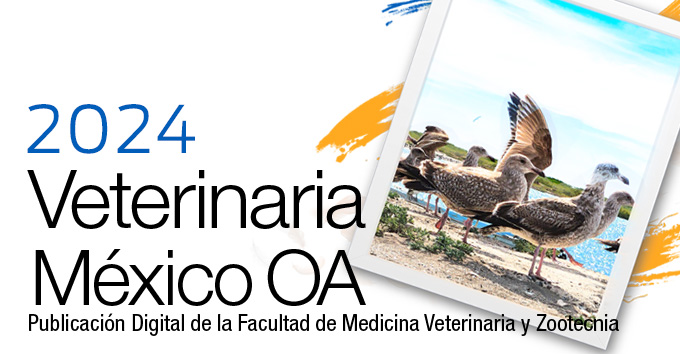Capture myopathy in wild birds: clinical information, a systematic review
Main Article Content
Abstract
Capture myopathy is a complication of handling in many species of mammals and wild birds. This pathology is described as a state of muscle tissue degradation that can render a bird unable to stand, walk or fly. This study is a systematic review of the literature on capture myopathy in wild birds with information searched between years 1980 to 2022. Taxonomic information, clinical signs, diagnostic methods, and treatments used in this pathology were compiled, summarized, and classified. A modified evaluation method was used for the methodological analysis of each of the articles, meeting inclusion and exclusion criteria, to have a desirable methodological quality, resulting in a total of 12 included studies. A higher prevalence of Capture myopathy was described in the families Scolopacidae, Gruidae and Anatidae. Frequent clinical signs associated with myopathy, were the inability to incorporate, ataxia, paresis, and paralysis. The diagnostic methods are based on clinical pathology, evaluating the enzymes creatine kinase and aspartate aminotransferase with their respective levels. Common macroscopic alterations were changes in the coloration of the muscle tissue and hemorrhagic areas due to rupture of myofibril and a frequent microscopic lesion was damage to muscle myofibers. The literature describes supportive treatments such as the early use of fluid therapy, analgesics, tranquilizers, vitamins, sodium bicarbonate, while physical therapy is beneficial to protect from injury and incorporate the bird to the environment as soon as possible, however, prevention is the most effective way to avoid the onset of this disease.
Article Details
References
Ward J, Gartrell B, Conklin J, Battley P. Midazolam as an adjunctive therapy for capture myopathy in Bar-tailed Godwits (Limosa lapponica baueri) with prognostic indicators. Journal of Wildlife Diseases. 2011;47(4): 925-935. doi.org/10.7589/0090-3558-47.4.925
Suárez Y. Parámetros morfológicos y fisiológicos de aves Passeriformes y mortalidad de la fauna silvestre ingresada al CAV (Centro de atención y valoración) de la CVS. [undergraduate thesis]. Montería, Colombia: Universidad de Córdoba; 2022
Vila L. Midazolam on restraint induced stress in wild birds. [Master thesis]. Goiânia, Brazil. Universidade Federal de Goiás; 2015.
Breed D, Meyer L, Steyl J, Goddard A, Burroughs R, Kohn T. Conserving wildlife in a changing world: understanding capture myopathy - a malignant outcome of stress during capture and translocation. Conservation Physiology. 2019; 7(1). doi.org/10.1093/conphys/coz027.
Dai W, Feng K, Sun X, Xu L, Wu S, Rahmand K, Jia D, Han T. Natural products for the treatment of stress-induced depression: pharmacology, mechanism, and traditional use. Journal of Ethnopharmacology. 2022; 285. doi.org/ 10.1016/j.jep.2021.114692
Obando-Calderón G, Acosta-Chaves V, Camacho P, Elizondo P, Montoya M, Oviedo S, Saénz Y. Aves en problemas. Las causas, cuándo y cómo ayudarlas. Zeledonia. 2014; 18(1).
Bedotti D, Mereb G, Fort M, Miranda A, Esain F. Miopatía post captura en Ciervo Colorado. Boletín de Divulgación Técnica, EEA Anguil. 2004; 79: 130-134.
McEntire M, Sánchez C. Multimodal drug therapy and physical rehabilitation in the successful treatment of capture myopathy in a lesser flamingo (Phoeniconaias minor). Journal of Avian Medicine and Surgery. 2017; 31(3): 232-238. doi.org/10.1647/2015-128.
Sierra E. Miopatía por estrés - síndrome de varamiento activo en cetáceos. Acta de la XXVIII Reunión de la SEAPV (Sociedad Española de Anatomía Patológica Veterinaria) Córdova, Argentina. 2016. https://helvia.uco.es/xmlui/handle/10396/14907
Hauer G. Capture myopathy. Bison producers from Alberta. 2001. https://www.bisoncentre.com/resources/resource-library/advanced-bison-information-producers/diseases-bison/capture-myopathy/.
Ushine N, Michishita M, Machida Y, Enomoto T, Sakai T, Kato T, Hayama S. Clinical examination and necropsy findings of a mountain hawk-eagle (Nisaetus nipalensis) that died during rehabilitation. Journal of Veterinary Medical Science. 2023; 85(1): 88-91. doi: 10.1292/jvms.22-0333.
Spraker T. Stress and capture myopathy in artiodactyls. In: Miller E, editor. Zoo and wild animal medicine. Current therapy. Philadelphia, Pennsylvania: WB Saunders Company; 1993.
Vanholder R, Sever M, Erek E, Lameire N. Rhabdomyolysis. review. Journal of the American Society of Nephrology. 2000; 11(8):1553-1561. doi.org/10.1681/ASN.V1181553.
Hernández R, Fernández C, Baptista M. Metodología de la investigación. 6ª. ed. México DF, México: Mac Graw Hill Education/Interamericana; 2014. 632 p.
Bobenrrieth M. Lectura crítica de artículos originales en salud. Medicina de Familia. 2001; 2: 81-90.
Page M, McKenzie J, Bossuyt P, Boutron I, Hoffmann T, Mulrow C, Shamseer L, Tetzlaff J, Akl E, Brennan S, Chou R, Glanville J, Grimshaw J, Hróbjartsson A, Lalu M, Li T, Loder E, Mayo-Wilson E, McDonald S, et al. The PRISMA 2020 statement: an updated guideline for reporting systematic reviews. BMJ. 2021; 372. doi.org/10.1136/bmj.n71
Hurtado H, Egert R, Poltronieri Santos, A, Rossi do Nascimento R, Silva I, Aragão I Thijl T. Successful treatment of capture myopathy and satellite transmitter injury in an Atlantic yellow-nosed albatross (Thalassarche chlororhynchos). Journal of Avian Medicine and Surgery. 2021: 35(2); 210-216. doi: 10.1647/20-00024.
Businga N, Langenberg J, Carlson L. Successful treatment of capture myopathy in three wild greater sandhill cranes (Grus canadensis tabida). Journal of Avian Medicine and Surgery. 2007; 21(4): 294–298. doi.org/10.1647/2005-013R1.1
Höfle U, Millá J, Gortázar C, Buenestado F, Marco I, Villafuerte R. Self-injury and capture myopathy in net-captured juvenile red-legged partridge with necklace radiotags. Wildlife Society Bulletin. 2004; 32(2): 344–350.
doi.org/10.2193/0091-7648(2004)32[344:SACMIN]2.0.CO;2
Hanley C, Thomas N, Paul-Murphy J, Hartup B. Exertional myopathy in whooping cranes with prognostic guidelines. Journal of Zoo and Wildlife Medicine. 2005; 36(3): 489-497. doi.org/10.1638/04-047.1
Hayes M, Hartup B, Pittman J, Barzen J. Capture of sandhill cranes using alpha-chloralose. Journal of Wildlife Diseases. 2003; 39(4): 859–868. doi.org/10.7589/0090-3558-39.4.859
Rogers D, Battley P, Sparrow J, Koolhaas A, Hassell C. Treatment of capture myopathy in shorebirds: a successful trial in Northwestern Australia. Journal of Field Ornithology. 2004; 75(2): 157-164. doi.org/10.1648/0273-8570-75.2.157
Finlay M, Jeske C. Capture myopathy in a captive Black-bellied whistling duck. Wildfowl. 1997; 48(48): 181-185.
Dunne R, Miller E. Successful treatment of a Canada goose (Branta canadensis) with presumed capture myopathy. 10 International effects of oil on Wildlife Conference. Tallinn, Estonia, 5-9 October. 2009.
Tully T, Hodgin C, Morris J, Williams J, Zebreznik B. Exertional myopathy in an Emu (Dromaius novaehollandiae). Journal of Avian Medicine and Surgery. 1996; 10(2): 96-100.
Carpenter J, Thomas N, Reeves S. Capture myopathy in an uendangered sandhill Crane (Grus canadensis pulla). Journal of Zoo and Wildlife Medicine. 1991; 22 (4): 488-493.
Rogers D, Battley F, Sparrow J, Koolhaas A, Hassell C. Treatment of capture myopathy in shorebirds: a successful trial in northwestern Australia. Journal of Field Ornithology. 2004; 75(2):157-164. doi.org/10.1648/0273-8570-75.2.157
Bollinger T, Wobeser G, Clark R, Nieman D, Smith J. Concentration of creatine kinase and aspartate aminotransferase in the blood of wild mallards following capture by three methods for banding. Journal of Wildlife Diseases. 1989. 25(2); 225-231. doi.org/10.7589/0090-3558-25.2.225.
Franson J, Murray H, Bunck C. Enzyme activities in plasma, kidney, liver, and muscle of five avian species. Journal of Wildlife Diseases. 1985; 21(1): 33-39. doi.org/10.7589/0090-3558-21.1.33.
West G, Heard D, Caulkett N. Capture myopathy. In: West G, Heard D, Caulkett N, editors. Zoo animal and wildlife Immobilization and anesthesia. Hoboken, New Jersey: Wiley & Sons Inc; 2014.
Blumstein D, Buckner J, Shah S, Patel S, Alfaro M, Natterson-Horowitz B. The evolution of capture myopathy in hooved mammals: a model for human stress cardiomyopathy. Evolution, Medicine, and Public Health. 2015; 1: 195-203. doi.org/10.1093/emph/eov015.
Paterson J. Capture myopathy. In: West G, Heard D, Caulkett N, editors. Zoo animal and wildlife Immobilization and anesthesia. Hoboken, New Jersey: Wiley & Sons Inc; 2014
License

Veterinaria México OA by Facultad de Medicina Veterinaria y Zootecnia - Universidad Nacional Autónoma de México is licensed under a Creative Commons Attribution 4.0 International Licence.
Based on a work at http://www.revistas.unam.mx
- All articles in Veterinaria México OA re published under the Creative Commons Attribution 4.0 Unported (CC-BY 4.0). With this license, authors retain copyright but allow any user to share, copy, distribute, transmit, adapt and make commercial use of the work, without needing to provide additional permission as long as appropriate attribution is made to the original author or source.
- By using this license, all Veterinaria México OAarticles meet or exceed all funder and institutional requirements for being considered Open Access.
- Authors cannot use copyrighted material within their article unless that material has also been made available under a similarly liberal license.



